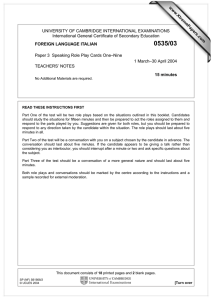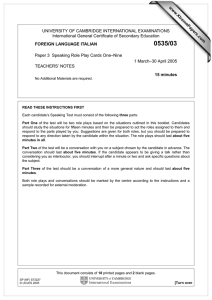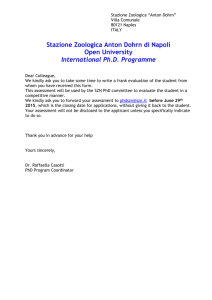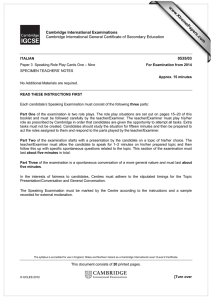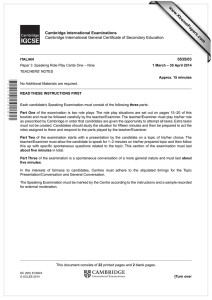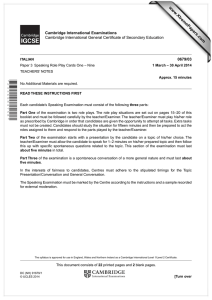0535/03 FOREIGN LANGUAGE ITALIAN
advertisement
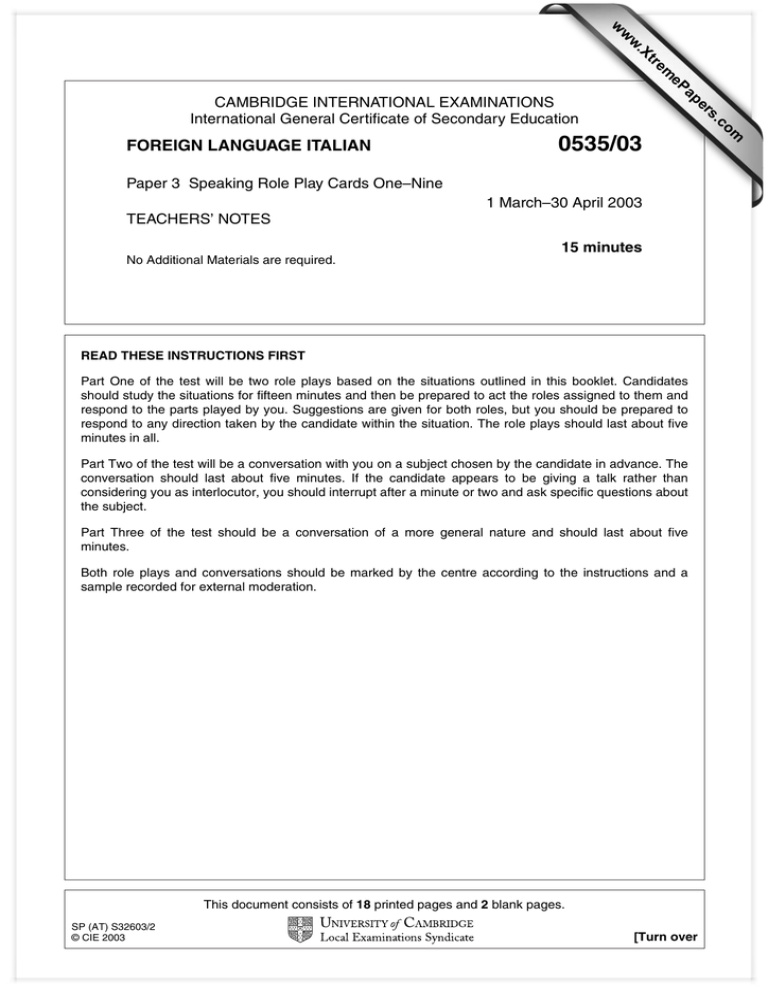
w w ap eP m e tr .X w 0535/03 Paper 3 Speaking Role Play Cards One–Nine 1 March–30 April 2003 TEACHERS’ NOTES 15 minutes No Additional Materials are required. READ THESE INSTRUCTIONS FIRST Part One of the test will be two role plays based on the situations outlined in this booklet. Candidates should study the situations for fifteen minutes and then be prepared to act the roles assigned to them and respond to the parts played by you. Suggestions are given for both roles, but you should be prepared to respond to any direction taken by the candidate within the situation. The role plays should last about five minutes in all. Part Two of the test will be a conversation with you on a subject chosen by the candidate in advance. The conversation should last about five minutes. If the candidate appears to be giving a talk rather than considering you as interlocutor, you should interrupt after a minute or two and ask specific questions about the subject. Part Three of the test should be a conversation of a more general nature and should last about five minutes. Both role plays and conversations should be marked by the centre according to the instructions and a sample recorded for external moderation. This document consists of 18 printed pages and 2 blank pages. SP (AT) S32603/2 © CIE 2003 [Turn over om .c FOREIGN LANGUAGE ITALIAN s er CAMBRIDGE INTERNATIONAL EXAMINATIONS International General Certificate of Secondary Education 2 Each candidate role play card contains two role plays. The list below gives details of the pages on which the role play cards appear in this booklet. CARD ONE A B Page 13 Page 16 CARD TWO A B Page 13 Page 17 CARD THREE A B Page 13 Page 18 CARD FOUR A B Page 14 Page 16 CARD FIVE A B Page 14 Page 17 CARD SIX A B Page 14 Page 18 CARD SEVEN A B Page 15 Page 16 CARD EIGHT A B Page 15 Page 17 CARD NINE A B Page 15 Page 18 0535/3/TN/M/J/03 3 ADMINISTRATIVE ARRANGEMENTS 1 The speaking tests take place in the two-three months before the main examination period, ie between 1 March and 30 April for the June examination. Each Centre decides on a convenient period within these dates for its speaking tests. It is important that dates given for the completion of the speaking tests and the despatch of recordings and mark sheets to CIE (see paragraph 6) are adhered to in order to allow sufficient time for moderation. 2 In the interests of standardisation there will be only one teacher/examiner per Centre. Each Centre selects its own teacher/examiner. This is normally a teacher from within the Languages Department, but could be someone local from outside the Centre. CIE is not responsible for any fees agreed. Where a Centre wishes to use additional teacher/examiners because it has a large number of candidates, permission to do so must be sought from the IGCSE Languages Officer before the start of each oral examination period. 3 Confidential test materials are despatched approximately two-three weeks before the assessment period. These should be opened four working days before the Centre’s assessment starts and studied carefully by the teacher/examiner before conducting his/her first tests. Teacher/examiners who have prepared their own roles fully and are confident in what they are doing are better able to help candidates who experience any difficulty. Once the materials have been opened, they remain confidential and must be kept in a secure place by the Centre until the end of the examination period. If permission is given to use more than one teacher/examiner, internal moderation must take place at the Centre to ensure that all its speaking tests are marked to the same standard. The sample submitted to CIE should include the work of each teacher/examiner and an Oral Examination Summary Mark Sheet should be submitted for each teacher/examiner, with candidate names and numbers clearly entered. 4 Each teacher/examiner will be required to record a sample of candidates from each Centre at which he or she examines. The teacher/examiner is asked to select and record six candidates, covering as wide a range of ability as possible. The candidates selected should be spread as evenly as possible across the range of marks (2 good, 2 middling, 2 weak): if there is a large range of marks (eg 40–90), teacher/examiners should be especially careful to send tests spread across the range, not just the top 2, middle 2 and bottom 2. This will enable the moderator to check accurately the standard of assessment. The recording should be carried out in accordance with the instructions headed “Recording of Candidates” (see paragraph 8). The recording must be sent to CIE together with the moderator copy of the completed MS1 Mark Sheet and a copy of the completed Oral Examination Summary Mark Sheet (see paragraphs 5 and 6). 5 Two types of mark sheet are provided: (a) One mark sheet (the Oral Examination Summary Mark Sheet) is intended as a working document, on which the marks for each section of the test are to be entered in detail as specified in the Marking Instructions. Be very careful to check all additions. (b) The total marks should then be transferred to the Internal Assessment Mark Sheet (MS1). 6 Despatch and return of mark sheets and recorded sample: (a) Mark sheets and recordings are to be returned to CIE once all the speaking tests have been completed. The deadline for receipt by CIE of these items is 15 May for the June examination. Do not wait until the end of the assessment period before despatching them. 0535/3/TN/M/J/03 [Voltare la pagina 4 (b) (i) The Board copy of the completed Internal Assessment Mark Sheet (MS1) must be returned to CIE in the separate envelope provided. (ii) The Moderator copy of the completed Internal Assessment Mark Sheet (MS1), a copy of the completed Oral Examination Summary Mark Sheet and the recorded sample must be sent to arrive at CIE by no later than 15 May for the June examination. (c) Copies of both types of mark sheet are to be retained by the Centre in case of postal losses or delays. 7 Arrangements for the examination (a) Examination conditions must prevail in the area where the examination takes place, including the space set aside for a candidate to prepare the role play situations. Adequate supervision must be provided to ensure that each candidate can study alone and in silence and that candidates leaving the interview room do not communicate with those waiting to enter. (b) Candidates are not allowed to bring any notes for use during their preparation time. Nor are they allowed to make notes. (c) Requests for special consideration for candidates with specific problems must be made on Special Consideration forms. (d) Candidates must be examined singly. No other person should be present during the examination with the exception of another teacher/examiner or an Officer from CIE. (e) As teacher/examiner you should be positioned so that you will be facing the candidates when they enter the room, with a table between you and the candidates. Please do not allow candidates to sit in a position where they can see what you are writing on the mark sheets as this can be distracting. (f) In order to put candidates at their ease, smile when they enter the room, and indicate where they should sit. A good teacher/examiner will usually send a candidate out of the interview room smiling, no matter how good or bad the performance has been. Avoid, however, the use of expressions such as “very good”, which a candidate may interpret as a comment on performance. (g) Please do not smoke in the presence of candidates. Smokers should arrange for breaks in the timetable as necessary, and to smoke elsewhere than in the interview room. (h) Other recommendations: do not walk about or distract candidates in any way (eg by doodling or fiddling with papers, etc); always appear interested, even in mundane matters; never show undue surprise, impatience or mockery; never correct a candidate. 8 Recording of candidates Centres should ensure well in advance of the test that a suitably quiet – and, if possible, small – room will be available and that their recording equipment is in good order. Rooms which are too close to a playground, recreation room or noisy classroom are to be avoided. It is essential that unnecessary background noise should be excluded. 0535/3/TN/M/J/03 5 Cassette recorders must be used and Centres will be responsible for ensuring the good quality of recordings. The cassette recorder and the cassette(s) to be used should be tested in situ some time before the actual test, ideally with one of the candidates. It is essential that new unrecorded cassettes are used. These will be supplied by CIE. Where possible it is advisable to use a cassette recorder with external microphones so that separate microphones can be used for the candidate and the teacher/examiner. If only one microphone is being used, it should be placed facing the candidate. With a softly-spoken candidate the microphone should be placed nearer to the candidate before the start of the test. Adjustments to the volume control during an examination should normally be avoided. The recording should begin at the start of Side 1 and care should be taken to avoid long gaps and extraneous noise. Both sides of each cassette should be used before beginning a new cassette. It is helpful if, at the end of examining on each side of a cassette, the teacher/examiner states “No further recordings on this side”. Each cassette should be introduced by the teacher/examiner as follows: “Centre Number eg ES 215 Centre Name eg King’s College, Madrid Examination Number 0535 Examination Name IGCSE Foreign Language Italian Name of Examiner eg Mr R Peters Date eg March 2nd 2003 ” Each candidate should be introduced by the teacher/examiner as follows: “Candidate Number eg 047 Candidate Name eg Jane Williams Role Play Card eg Number 4 ” At the end of the sample, please state “End of sample”. Once a test has begun, the cassette should run without interruption. On no account should you stop and re-start the cassette during a test. The contents of each cassette should be clearly labelled. Before the cassette is despatched, spot checks must be made to ensure that every candidate is clearly audible. Cassettes should then be rewound to the start of Side 1. 0535/3/TN/M/J/03 [Voltare la pagina 6 STRUCTURE OF THE EXAMINATION Test 1: Role Plays (about 5 minutes) 30 marks (a) Each candidate will be examined in two role play situations selected at random by the teacher/examiner from the cards supplied. Each card will contain two situations, both of which will be examined. A number of alternative cards are supplied, and these should be used at random during each session of examining. Having given the first candidate 15 minutes to prepare his/her two situations, you should hand a different card to the second candidate to prepare while you examine the first candidate. Candidates may take the role play card they have prepared into the examination room. However, they may not take the role play card away with them once the examination is over. (b) Unless there are exceptional circumstances (eg speech impediments) each situation should be carried out in full. If the candidate cannot handle one of the tasks set, the teacher/examiner should not leave too long a pause but should lead the candidate on to the next task. (c) Should a candidate miss out a task, the teacher/examiner should try to guide him/her back to it, in as natural a way as possible. It does not matter to Moderators that this may lead to tasks occurring in a different order, as long as they are all attempted. (d) The roles of the candidate and teacher/examiner are indicated on the cards. Teacher/examiners are asked to prepare the situations carefully so that the candidate’s tasks follow on naturally from the teacher/examiner’s response. Usually, the teacher/examiner has to initiate the dialogue. The teacher/examiner is to assume the role of a well-disposed native speaker with no knowledge of the candidate’s first language. Suggested responses are given on pages 13 –18 of this document. For marking pattern, see Table A of the Marking Instructions. Test 2: Topic (prepared) Conversation (about 5 minutes) 30 marks This section is intended to be a conversation between the teacher/examiner and the candidate on one topic of the candidate’s choice. Suitable subjects might be, for example: ‘School life’, ‘Hobbies and pastimes’ (general or specific). ‘My country’, ‘Life in another country’, ‘My ambitions’, ‘Holidays’. These are only examples: candidates should be encouraged to choose a topic in which they have a personal interest. Topics dealing with politics or social and economic issues are ambitious for this level of achievement and may disadvantage candidates if they do not possess the linguistic skills and maturity of ideas which such topics necessitate. Candidates should be encouraged to prepare different topics within a Centre and should not be allowed to present ‘Myself’ or ‘My life’ as topics as these can become too general and can often pre-empt the General (unprepared) Conversation section. The topic must be prepared by candidates in advance, but must not be pre-learnt and delivered as a monologue. The teacher/examiner should allow the candidate to speak on their choice of topic for one to two minutes uninterrupted and then follow this up with specific questions on the topic. Where a candidate has been talking for two minutes and shows no sign of finishing their initial exposition, the teacher/examiner must interrupt and ask specific questions. It is the extent to which candidates can manipulate their prepared material according to the needs of the teacher/examiner that determines their marks. Candidates may use illustrative material, eg photographs, if this seems appropriate to their topic, but are not allowed to use written notes of any kind. 0535/3/TN/M/J/03 7 The candidate must show quality of preparation, but must not be allowed to deliver a prepared monologue or a series of obviously prepared replies. You, as teacher/examiner, must try to lead the candidate into using a variety of tenses as candidates who do not show that they are able to convey past and future meaning cannot be awarded a mark in the Satisfactory band or above on Scale (b) (see Table B of the Marking Instructions). In order to extend the candidate as far as possible you should probe, explore, ask for explanations, enlargements, descriptions (how? when? why? tell me a bit more about... etc). For marking pattern, see Table B of the Marking Instructions. Test 3: General (unprepared) Conversation (about 5 minutes) 30 marks (a) You should normally allow the stipulated length of time for each candidate. Whilst some candidates may dry up after a few minutes, you should persevere with the conversation (eg by complete changes of subject), so that candidates are given every opportunity to do themselves justice. (b) The discussion of the topic will have paved the way for the unprepared conversation. You should start out from any point of interest noted earlier, or ask general questions relating to the candidate’s everyday life, school (subjects, number of periods, times, games, etc), home, town, journey to and from school, free time (evenings, weekends), holidays, hobbies. All candidates can reasonably be expected to have the command of vocabulary and idiom necessary for this. You should aim to cover at least two or three of the Defined Content Topics in this section of the test (these are listed in the Curriculum Content section of the syllabus booklet). As in the Topic Conversation, you must try to lead the candidate into using a variety of tenses (themes could be visits to other countries, plans for the future, etc) and he or she can then be extended as far as possible. Candidates who do not show that they are able to convey past and future meaning cannot be awarded a mark in the Satisfactory band or above on Scale (b) (see Table B of the Marking Instructions). Precise factual information or knowledge is not required, and candidates should not be penalised for lack of such knowledge. Be ready to pass on quickly to another subject if candidates are obviously out of their depth. Take care to avoid questions which might cause embarrassment, eg where a candidate has only one parent. (Centres are requested to supply such information to the teacher/examiner in advance.) (c) Candidates should be expected to give natural replies to questions; their answers need not therefore be in the form of complete sentences. You should take care to avoid questions inviting simply “yes” or “no” by using a variety of interrogatives, eg when? how? why? how many? how long? with whom? with what? etc. (d) Questions should be adjusted to the candidate’s ability. Candidates should be prompted and encouraged where necessary and long silences should be avoided. On the other hand, do not interrupt a candidate unless you are sure that he or she cannot complete the answer. Incorrect answers should never be corrected, nor answers supplied when none are given. Questions should be rephrased (rather than repeated) in an attempt to maintain the dialogue. (e) The use of vocabulary or phrases from the candidate’s first language should be avoided, except in the case of particular institutions, eg names of examinations, types of school, etc. (f) Beware of talking too much and giving the candidate credit for what you have in fact said yourself. The onus is on the candidate to show that he or she can converse adequately in the language, but at the same time it is up to you to make sure that the candidate is given every opportunity to do so by following up any opening given. For marking pattern, see Table B of the Marking Instructions. 0535/3/TN/M/J/03 [Voltare la pagina 8 Test 4: Impression 10 marks At the end of the test you should make an assessment of the candidate’s pronunciation, accent and fluency, following the guidelines given in the Marking Instructions. While you may use the opportunity of the candidate’s introduction to the topic to assess these factors, your final assessment must be based on the candidate’s overall performance. Exceptional performance in the role play situations (ie one in which a fluid and natural conversation develops) should be rewarded by a high impression mark. For marking pattern, see Table C of the Marking Instructions. 0535/3/TN/M/J/03 9 MARKING INSTRUCTIONS Use the Oral Examination Summary Mark Sheet. Test 1 Role Plays. 30 marks. Use Table A. Enter the mark for each task in the ten columns 1-10 on the Oral Examination Summary Mark Sheet. Test 2 Topic Conversation. 30 marks. Use Table B. (i) A mark out of 15 on Scale (a) Comprehension/responsiveness. Enter the mark in column 11. (ii) A mark out of 15 on Scale (b) Linguistic content. Enter the mark in column 12. Test 3 General Conversation. 30 marks. Use Table B. Mark as for Test 2 using Table B. Enter marks out of 15 in columns 13 and 14. Test 4 Impression. 10 marks. Use Table C. Enter the mark in column 15. Add the marks and enter the total, in large figures, in the column headed Total Mark. Please double check the addition as even small errors create problems. Marking: General Principles 1 You are urged to use the full range of marks, bearing in mind that it is not necessary for a candidate to be of native speaker standard in order to be given maximum marks within any single category. 2 The general approach is a positive one and you should award marks based on what the candidate can do rather than deducting marks for errors. 3 Above all else, please be consistent in your marking. The moderation process allows for adjustments to be made to consistently harsh or consistently generous marking. If you are unsure of the mark to award, err on the side of generosity. 0535/3/TN/M/J/03 [Voltare la pagina 10 TABLE A – Test 1: Role Plays (30 marks) This part of the examination is primarily a test of the candidate’s ability to communicate needs, information, requests, etc, in plausibly life-like situations. Intelligibility is therefore of greater importance than grammatical or syntactic accuracy. However, verbal communication only will be assessed: credit will not be given for gestures, facial expressions or other non-verbal forms of communication. The use of appropriate register and correct idiom will be rewarded. The teacher/examiner will play the part of a patient and well-disposed foreigner with no knowledge of the candidate’s first language. Each of the ten tasks to be performed in the examination will be assessed on the scale below. Candidates will be required to give natural responses, not necessarily in the form of “sentences”: short answers, if appropriate to the task, can be awarded 3 marks. Marks are awarded as follows: An accurate utterance which not only conveys the meaning but which is expressed in native idiom and appropriate register. Minor errors (adjective endings, use of prepositions, etc) are tolerated. The utterance is intelligible and the task of communication is achieved. 3 The language used is not necessarily the most appropriate to the situation and may contain inaccuracies which do not obscure the meaning. 2 Communication of some meaning is achieved, but the native speaker would find the message ambiguous or incomplete. 1 The utterance is unintelligible to the native speaker. 0 NB 1 Teacher/examiners are reminded that if there are two elements in a task and only one is completed, then a maximum of one mark only may be awarded. 2 When awarding marks, teacher/examiners should start at the bottom of the mark scheme and work upwards: 0 = nothing of worth communicated 1 = partial communication 2 = all points communicated – but with some linguistic inaccuracies – meaning clear 3 = meaning clear and accurately conveyed. 3 Short utterances, if appropriate, can be worth three marks – especially true in Role Play A. 0535/3/TN/M/J/03 11 TABLE B – Tests 2 and 3: Topic Conversation and General Conversation (2 x 30 marks) Scale (a) Comprehension/responsiveness. This assesses the candidate’s response in terms of comprehension of the teacher/examiner, immediacy of reaction/response, fluency of response, presentation of material in the topic. Scale (b) This assesses the linguistic content of the candidate’s answers in terms of the complexity, accuracy and range of structures, vocabulary and idiom. NB This table is used for Tests 2 AND 3. Category Outstanding Mark (a) Not necessarily of native speaker standard. (b) The highest level to be expected of the best IGCSE candidates. Very good (a) Generally understands questions first time, but may require occasional re-phrasing. Can respond satisfactorily to both straightforward and unexpected questions. (b) Wide range of mostly accurate structures, vocabulary and idiom. Good 7-9 (a) Has difficulty even with straightforward questions, but still attempts an answer. (b) Shows elementary, limited vocabulary and faulty manipulation of structures. Poor 10-11 (a) Understands straightforward questions but has difficulty with some unexpected ones and needs some re-phrasing. Fairly fluent, but some hesitation. (b) Adequate range of structures and vocabulary. Can convey past and future meaning; some ambiguity. Weak 12-13 (a) Has no difficulty with straightforward questions and responds fairly well to unexpected ones, particularly when they are rephrased. (b) Good range of generally accurate structures, varied vocabulary. Satisfactory 14-15 4-6 (a) Frequently fails to understand the questions and has great difficulty in replying. (b) Shows very limited range of structures and vocabulary. 0535/3/TN/M/J/03 0-3 [Voltare la pagina 12 TABLE C – Impression (10 marks) Very good pronunciation, intonation and fluency; an occasional slight mistake or hesitation. Not necessarily of native speaker standard. 9-10 Good pronunciation and fluency; makes a fair attempt at correct intonation and expression; some mistakes and/or hesitation. 7-8 A fair degree of fluency and accuracy in pronunciation despite quite a number of errors; some attempt at intonation and expression. 5-6 Conveys some meaning despite a lack of fluency and many errors; pronunciation strongly influenced by first language. 3-4 Many gross errors; frequently incomprehensible. 1-2 0535/3/TN/M/J/03 13 For Role Play Cards One, Two, Three. Role Play A. A Candidato/a: in vacanza in Italia Insegnante: cameriere/cameriera in un caffè Sei in Italia in vacanza e vai in un caffè con un amico/un’amica. I Saluti il candidato/la candidata e chieda: “Desidera?” C Saluta il cameriere/la cameriera e di’ che volete mangiare qualcosa. I Dica che avete panini al prosciutto o al formaggio, e pizze. C Ascolta il cameriere/la cameriera, e scegli 2 cose (una per te e una per il tuo amico/la tua amica). I Risponda in modo appropriato e chieda: “E da bere?” C Ordina 2 cose diverse da bere. I Risponda in modo appropriato. C (5 minuti dopo il cameriere/la cameriera ritorna con quello che hai ordinato, ma con una sola cosa da bere). Cosa dici? I Si scusi e chieda se desiderano altro. C Chiedi il conto e poi fai un’altra domanda (toilette?). I Risponda in modo appropriato alla domanda e concluda la conversazione. 0535/3/TN/M/J/03 [Voltare la pagina 14 For Role Play Cards Four, Five, Six. Role Play A. A Candidato/a: in vacanza in Italia Insegnante: impiegato/impiegata di un ufficio del turismo Sei in vacanza in Italia con la tua famiglia. Lì vicino c’è un famoso castello che volete visitare. Vai all’ufficio del turismo per avere informazioni. I Saluti il candidato/la candidata. C Saluta l’impiegato/l’impiegata e spiega cosa volete fare. I Dica che è un castello bellissimo e antico. C Chiedi informazioni sull’orario di apertura e di chiusura. I Dica che il castello apre alle 10 e chiude alle 14. Poi riapre alle 17 e chiude alle 20. C Fai una domanda sui servizi del castello (ristorante? parcheggio?). I Risponda in modo appropriato. C Chiedi quanto costa il biglietto d’ingresso. I Dica che costa 20 euro per gli adulti e 12 euro per i ragazzi. C Di’ quanti biglietti vuoi per te e la tua famiglia (adulti? ragazzi?). I Spieghi che i biglietti si comprano al castello e concluda la conversazione. 0535/3/TN/M/J/03 15 For Role Play Cards Seven, Eight, Nine. Role Play A. A Candidato/a: in vacanza in Italia Insegnante: farmacista Durante le tue vacanze in Italia stai male e vai dal farmacista per farti dare una medicina. I Saluti il candidato/la candidata. C Saluta il/la farmacista e di’ che non stai bene. I Chieda al candidato/alla candidata “Che disturbi ha?”. C Spiega che disturbi hai. I Chieda al candidato/alla candidata se ha altri disturbi. C Descrivi gli altri disturbi che hai. I Chieda quanto tempo è che non sta bene. C Di’ quando hai cominciato a non sentirti bene. I Dia al candidato/alla candidata una medicina. C Ringrazia il/la farmacista e chiedi il prezzo della medicina. I Risponda in modo appropriato e concluda la conversazione. 0535/3/TN/M/J/03 [Voltare la pagina 16 For Role Play Cards One, Four, Seven. Role Play B. B Candidato/a: in vacanza in Italia Insegnante: un amico/un’amica Hai un appuntamento con un amico italiano/un’amica italiana per andare al cinema, ma sai che arriverai in ritardo. Telefoni al tuo amico/alla tua amica per spiegare la situazione. I Risponda al telefono. C Saluta il tuo amico/la tua amica e di’ perché telefoni. I Chieda come mai sarà in ritardo. C Spiega che hai avuto una discussione con tuo padre/tua madre e hai perso l’autobus. I Chieda a proposito di cosa era la discussione. C Spiega a proposito di cosa avete avuto una discussione (esempio: stanza in disordine, cattivi risultati scolastici). I Dica “È proprio un peccato – così perderemo l’inizio del film”. C Scusati. Proponi un’altra cosa da fare insieme. I Lei pensa che sia una buona idea. Chieda: (i) a che ora vi troverete; (ii) dove potete incontrarvi. C Ascolta le domande e rispondi in modo appropriato. I Risponda in modo appropriato e concluda la conversazione. 0535/3/TN/M/J/03 17 For Role Play Cards Two, Five, Eight. Role Play B B Candidato/a: in vacanza in Italia Insegnante: proprietario/proprietaria di un ristorante Mentre sei al ristorante qualcuno ruba la tua giacca. Parli con il proprietario/la proprietaria del ristorante. I Saluti il candidato/la candidata e dica che la cameriera le ha accennato che c’è un problema. C Saluta il proprietario/la proprietaria e spiega qual è il problema. I Reagisca mostrandosi inorridito/a e sorpreso/a e chieda al candidato/alla candidata quando ha visto la sua giacca per l’ultima volta. C Di’ quando hai visto la tua giacca per l’ultima volta. I Chieda al candidato/alla candidata di descrivere la giacca. C Descrivi la giacca (2 particolari). I Chieda se c’era qualcosa nelle tasche. C (Problema: il tuo portafoglio/portamonete era in una tasca della giacca). Spiega con tatto che non potrai pagare il conto. I Dica di non preoccuparsi. Dica che lei telefonerà alla polizia e poi domandi: (i) se il candidato/la candidata è qui in vacanza; (ii) dove è alloggiato/a. C Rispondi alle domande del proprietario/della proprietaria. I Spieghi che aspetterà l’arrivo della polizia e che, se necessario, qualcuno accompagnerà a casa il candidato/la candidata. Concluda la conversazione. 0535/3/TN/M/J/03 [Voltare la pagina 18 For Role Play Cards Three, Six, Nine. Role Play B. B Candidato/a: te stesso/te stessa Insegnante: amico italiano/amica italiana It tuo amico/la tua amica vorrebbe venire da te per le vacanze, ma la tua famiglia sta per trasferirsi e andare ad abitare in un altro Paese. Tu telefoni al tuo amico/alla tua amica. I Risponda al telefono. C Saluta il tuo amico/la tua amica e spiega in modo educato per quale ragione non potrà venire da te per le vacanze. I Chieda al candidato/alla candidata perché va ad abitare in un altro Paese. C Spiega perché vi trasferite (lavoro di tuo padre/di tua madre?). I Chieda quando partono. C Di’ la data esatta della partenza e di’ il nome del Paese nel quale andrai ad abitare. I Lei è molto dispiaciuto/a – chieda se può andare a trovare il candidato/la candidata nel nuovo Paese. C Rispondi positivamente alla domanda del tuo amico/della tua amica di venirti a trovare nella nuova casa. Suggerisci una data. I Reagisca dimostrando la sua contentezza e dica che ne parlerà ai suoi genitori. C Di’ quando e come ti metterai in contatto con il tuo amico/la tua amica. I Risponda in modo appropriato e concluda la conversazione. 0535/3/TN/M/J/03 19 BLANK PAGE 0535/3/TN/M/J/03 20 BLANK PAGE 0535/3/TN/M/J/03
